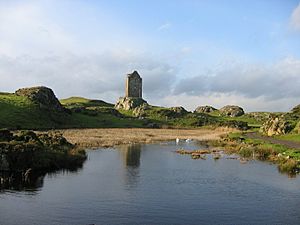Smailholm Tower facts for kids
Smailholm Tower is an old stone tower in the Scottish Borders. It's about five miles (8 km) west of Kelso. This tower sits on top of a rocky hill called Lady Hill. From there, you can see far across the countryside. Smailholm Tower is a special historical site. It is now looked after by Historic Environment Scotland. In 2007, it was even given a "five-star" rating as a tourist spot!
What is Smailholm Tower?
Smailholm Tower is a type of building called a peel tower. These towers were built a long time ago, usually in the 15th or early 16th century. They were designed to protect people from attacks, especially from raiders coming across the border from England.
Who Built Smailholm Tower?
The Pringle family built Smailholm Tower. They were also known as the Hoppringles. This family owned the land around Smailholm starting in the 1400s. The name "Smailholm" comes from old words. "Smail" means "small" or "thin," and "holm" means "little island."
When Was the Tower Attacked?
Life was tough back then! Smailholm Tower was attacked several times by English soldiers. This happened in 1543, 1544, and again in 1546. During one attack, soldiers from Wark Castle took prisoners and cattle. But the tower was also successfully defended. For example, Sir Andrew Ker of Greenhead protected it in 1640.
Who Owned the Tower Later?
Later, the Scotts of Harden family took over Smailholm. This family is related to the famous writer Sir Walter Scott. The Scotts fixed up parts of the tower. But in the 1700s, the family moved to a nearby farm called Sandyknowe. The tower then started to fall apart. In 1950, the last owner gave the tower to the state. It was fixed up again in the 1980s and is now a museum.
Exploring Smailholm Tower
Smailholm Tower is not huge, but it's very strong. It has four floors and is built on a rocky hill. The walls are very thick, about 2.4 meters (8 feet) wide!
Inside the Tower
The main door is on the south side. Inside, there's a spiral staircase in the corner. The bottom floor was used for storage. Above that is the main hall, where people would gather. It has a fireplace with a cool carved face on it. The very top floor has a special curved stone roof. This roof supports stone flags on top. There are also walkways along the top edges of the tower.
The Courtyard and Outbuildings
Around the tower, you can still see the remains of a stone wall. This wall was called a barmkin, which means a courtyard. Inside this courtyard, there were other buildings. You can see where a small chapel and other rooms used to be. The western part of the courtyard is still quite clear. It has walls that are almost as tall as the first floor.
What Can You See Today?
Today, Smailholm Tower is a museum. It has a cool display of model people. These models show the history of Smailholm and stories from Sir Walter Scott's books. Local artists made these models using embroidery and special techniques. The tower also has a special "turf roof" now. This helps protect the old building from dampness.
Sir Walter Scott and Smailholm
Smailholm Tower was very important to the famous Scottish writer Sir Walter Scott. He spent a lot of time here when he was a boy. He would visit his grandfather at a nearby farm. Scott was often sick as a child, and the fresh air at Smailholm helped him.
How the Tower Inspired Scott
The tower inspired Scott's writing. It is the setting for his poem The Eve of St John. It also appears in another of his famous poems, Marmion. Because of Scott's poems, his uncle even helped fix up the tower around 1800 to make it safe.
Artists and Photographers
Later, the artist Turner visited Smailholm with Scott. Turner drew a sketch of the tower. This drawing was included in Scott's Poetical Works. Even the pioneer of photography, Fox Talbot, visited Smailholm. He took pictures of the tower and other places Scott wrote about. He published these photos in a book called Sun Pictures in Scotland.
See also
 In Spanish: Torre de Smailholm para niños
In Spanish: Torre de Smailholm para niños



